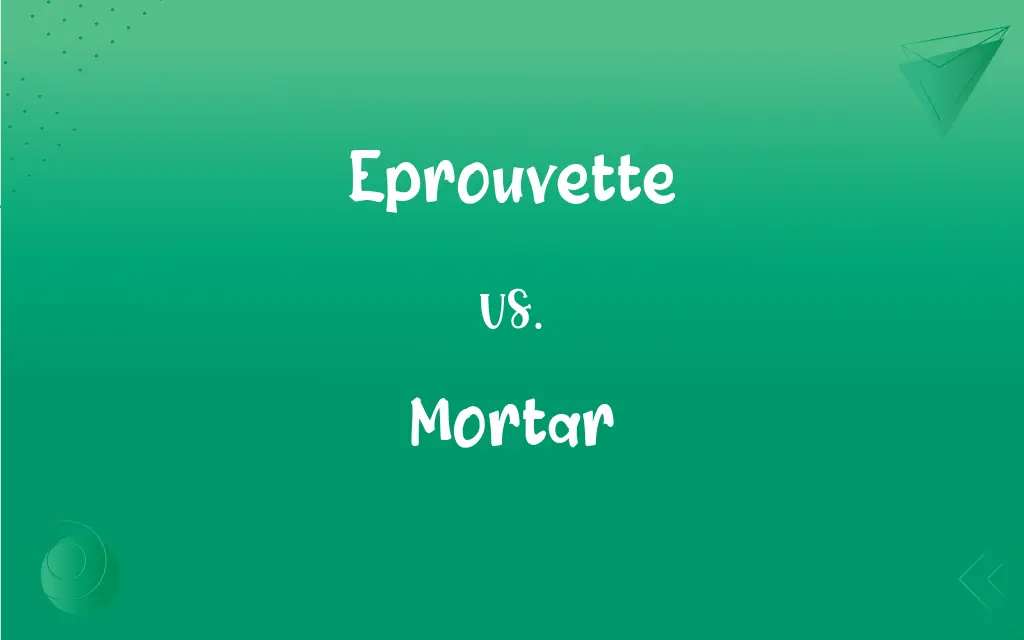Eprouvette vs. Mortar: What's the Difference?
By Janet White || Updated on March 4, 2024
Eprouvette is a device for measuring powder strength, while a mortar is a tool for grinding.

Key Differences
Eprouvette, historically, refers to an instrument used to test the strength or quality of gunpowder. It worked by measuring the force of the gunpowder when ignited, which provided an empirical value to gauge its potency. This device was crucial in periods when the consistency of gunpowder production could vary significantly. Whereas, a mortar is a simple device that has been used since ancient times, consisting of a bowl (the mortar) and a heavy club-shaped object (the pestle). The primary purpose of a mortar and pestle is to crush, grind, or mix substances. This tool is versatile, being found in kitchens for culinary purposes, in pharmacies for preparing medicines, and in laboratories for scientific research.
While an eprouvette is specifically designed for the narrow purpose of testing gunpowder and has historical significance, particularly in military contexts, a mortar serves a broad range of practical applications beyond just mixing or grinding substances. On the other hand, mortars are still widely used today in various fields for their intended purpose, showcasing their enduring relevance and utility.
The operation of an eprouvette involves a controlled explosion, where a small amount of gunpowder is ignited to observe its strength, which is then measured by the distance an object is propelled or by the pressure exerted. This process requires careful handling and a specific setup to ensure accurate results. Conversely, using a mortar and pestle requires manual effort to crush or grind substances, relying on physical force applied by the user. This difference highlights the contrasting nature of their functions and the types of measurements they provide.
Eprouvettes are largely of historical interest now, found in museums or as collectibles, representing an era of manual testing methods before the advent of modern chemical analysis techniques. They symbolize the evolution of scientific inquiry and military engineering. In contrast, mortars continue to be an essential tool in many cultures and professions, symbolizing the continuity of traditional practices in the modern age.
Despite their differences, both eprouvettes and mortars share the commonality of being tools designed to manipulate materials to achieve a specific outcome whether it's testing the potency of gunpowder or preparing ingredients for a recipe. This reflects the diverse ways in which human ingenuity has developed specialized tools to meet specific needs.
ADVERTISEMENT
Comparison Chart
Purpose
Testing gunpowder strength
Grinding or mixing substances
Usage Context
Historical, primarily military
Culinary, pharmaceutical, scientific
Operation
Controlled explosion
Manual grinding or crushing
Relevance Today
Mostly historical interest
Widely used in various fields
Measurement
Force or pressure
Not applicable
ADVERTISEMENT
Eprouvette and Mortar Definitions
Eprouvette
A historical tool for gauging gunpowder potency.
Museums display eprouvettes as part of their military collections.
Mortar
A tool for mixing substances.
The pharmacist prepared the compound in a mortar.
Eprouvette
An instrument for testing explosive force.
They used an eprouvette to ensure the consistency of the explosive material.
Mortar
An implement for culinary preparation.
A granite mortar is ideal for making pesto.
Eprouvette
A device used to measure the strength of gunpowder.
The eprouvette indicated the gunpowder was of high quality.
Mortar
A device in pharmacies for medicine preparation.
He meticulously ground the ingredients in a mortar.
Eprouvette
A measure of gunpowder effectiveness.
The eprouvette results determined the batch's usability.
Mortar
A kitchen utensil for food processing.
The chef recommends using a mortar for authentic flavors.
Eprouvette
A tester for explosive materials' strength.
Before modern techniques, an eprouvette was essential for safety checks.
Mortar
A bowl used for crushing or grinding.
She used a mortar and pestle to grind the spices.
Eprouvette
A one-piece, fixed-elevation mortar formerly used to test the strength of gunpowder.
Mortar
A vessel in which substances are crushed or ground with a pestle.
Eprouvette
An apparatus for testing or proving the strength of gunpowder.
Mortar
A machine in which materials are ground and blended or crushed.
Mortar
A portable, usually muzzleloading cannon used to fire shells at low velocities, short ranges, and high trajectories.
Mortar
A shell fired by such a cannon.
Mortar
Any of several similar devices, such as one that shoots life lines across a stretch of water.
Mortar
A short, usually stationary, muzzleloading cannon used from the 1700s to early 1900s to fire large round shells at low velocities, short ranges, and high trajectories.
Mortar
Any of various bonding materials used in masonry, surfacing, and plastering, especially a mixture of cement or lime, sand, and water that hardens in place and is used to bind together bricks or stones.
Mortar
To bombard with mortar shells.
Mortar
To plaster or join with mortar.
Mortar
(uncountable) A mixture of lime or cement, sand and water used for bonding building blocks.
Mortar
(countable) A muzzle-loading, indirect fire weapon with a tube length of 10 to 20 calibers and designed to lob shells at very steep trajectories.
Mortar
(countable) A hollow vessel used to pound, crush, rub, grind or mix ingredients with a pestle.
Mortar
(countable) In paper milling, a trough in which material is hammered.
Mortar
(transitive) To use mortar or plaster to join two things together.
Mortar
(transitive) To pound in a mortar.
Mortar
To fire a mortar (weapon).
Mortar
To attack (someone or something) using a mortar (weapon).
The insurgents snuck up close and mortared the base last night.
Mortar
A strong vessel, commonly in form of an inverted bell, in which substances are pounded or rubbed with a pestle.
Mortar
A short piece of ordnance, used for throwing bombs, carcasses, shells, etc., at high angles of elevation, as 45°, and even higher; - so named from its resemblance in shape to the utensil above described.
Mortar
A building material made by mixing lime, cement, or plaster of Paris, with sand, water, and sometimes other materials; - used in masonry for joining stones, bricks, etc., also for plastering, and in other ways.
Mortar
A chamber lamp or light.
Mortar
To plaster or make fast with mortar.
Mortar
A muzzle-loading high-angle gun with a short barrel that fires shells at high elevations for a short range
Mortar
Used as a bond in masonry or for covering a wall
Mortar
A bowl-shaped vessel in which substances can be ground and mixed with a pestle
Mortar
Plaster with mortar;
Mortar the wall
FAQs
Are mortars used outside of cooking?
Yes, in pharmacies for medicines and in labs for scientific research.
How does an eprouvette measure gunpowder strength?
By observing the distance an object is propelled or the pressure exerted upon ignition.
Can you still find eprouvettes today?
Yes, primarily as historical artifacts in museums or collections.
What materials can you grind in a mortar?
Spices, herbs, grains, or any solid substance needing to be pulverized.
What's the main difference between an eprouvette and a mortar?
An eprouvette tests gunpowder strength, while a mortar is for grinding substances.
Do modern kitchens still use mortars?
Yes, for their ability to extract flavors and textures not achievable with electric grinders.
What is an eprouvette used for?
It's used to measure the strength or quality of gunpowder.
Were eprouvettes used in any specific period?
Primarily before the 20th century, when manual testing was common.
Is it easy to use a mortar and pestle?
With some practice, it becomes an easy and effective tool for grinding and mixing.
Is the mortar and pestle still relevant today?
Absolutely, it remains a vital tool in kitchens, pharmacies, and labs worldwide.
How do you clean a mortar?
Rinse with water and scrub; some materials like granite also require oiling.
What makes eprouvettes collectible?
Their historical significance and uniqueness as scientific instruments.
Did all countries use eprouvettes?
Many did, especially those with significant military or scientific communities.
Do eprouvettes vary in design?
Yes, there were variations based on the period and the specific use.
How accurate were eprouvettes?
They provided a relative measure of potency, but modern methods are more precise.
Can an eprouvette be used for anything other than gunpowder?
It was specifically designed for gunpowder, making it unsuitable for other uses.
Why is a mortar preferred over an electric grinder for some tasks?
It allows for better control over texture and can release more flavor from ingredients.
Are there different types of mortars?
Yes, including materials like wood, stone, ceramic, and metal, each with its use.
Can I make my own mortar at home?
It's possible but buying one designed for the purpose is usually more effective.
What was the historical importance of the mortar?
It has been an essential tool for culinary, medicinal, and scientific preparation for centuries.
About Author
Written by
Janet WhiteJanet White has been an esteemed writer and blogger for Difference Wiki. Holding a Master's degree in Science and Medical Journalism from the prestigious Boston University, she has consistently demonstrated her expertise and passion for her field. When she's not immersed in her work, Janet relishes her time exercising, delving into a good book, and cherishing moments with friends and family.































































